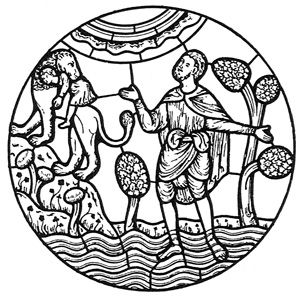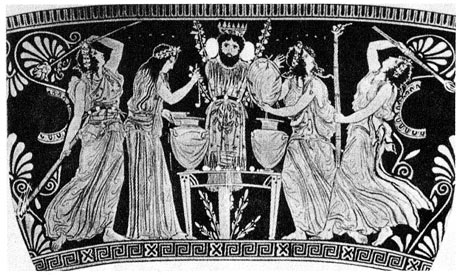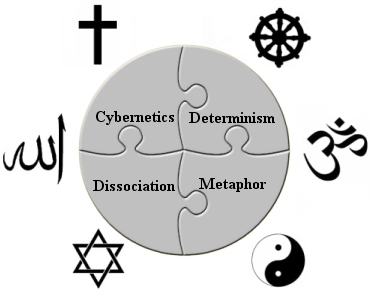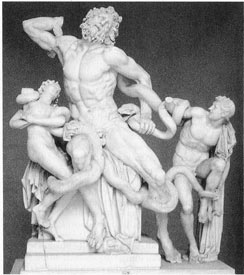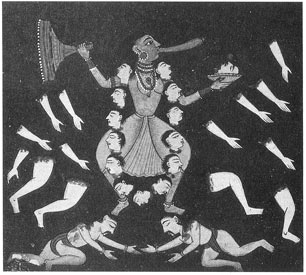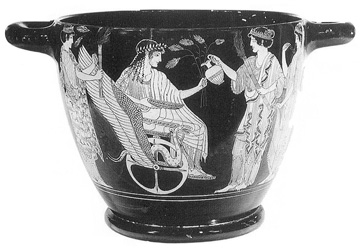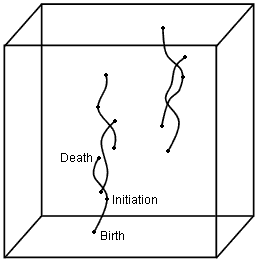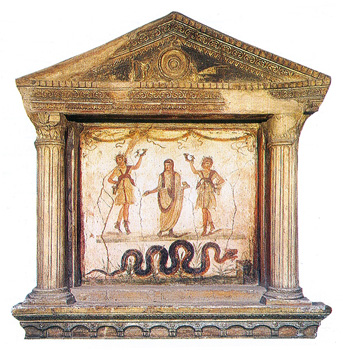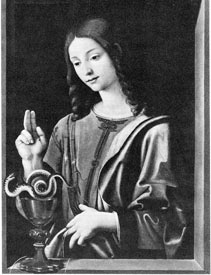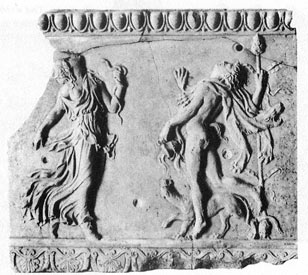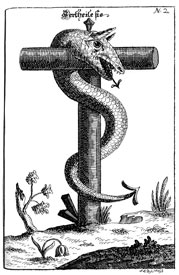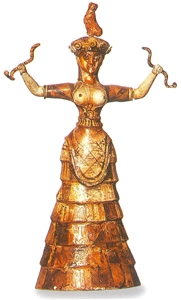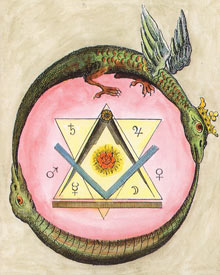The Entheogen Theory of Religion and Ego Death
by
Michael Hoffman
September 24, 2006
Salvia Divinorum, Issue 4
Contents
The Entheogen Theory of Religion
Origins of Christianity in Entheogenic Initiation
Sociopolitical Strategy of Canonical Christianity
Altered State Integrated into Ancient Culture
Modernity a Single-State Culture
Freedom for Higher-Order Religion
Role of Democracy for Ecstatic Danger
Initiation as Natural Developmental Sequence
The Entheogenic Future of Religion
The Dissociative
Cognitive State
Restructuring Enabled by Loose Association Binding
Splitting of Representation and Referent Layers
The Moving Control-Agent as Mental Construct
Religious Effects of Salvia Divinorum
Myth Describes Dissociative Phenomena
The Block
Universe and Frozen Worldlines
Time as a Space-like Dimension.
Physical Fastening of All Thoughts and Actions
Fixed Worldlines of Subjective Experiencing
Accommodation to Everything Being Pre-set
Vertical, Timeless Determinism..
Two Jumps to Transcend Determinism
Fatedness and Control in Astral Ascent Mysticism
Self-Control and
the Hidden Source of Thoughts
The Goal of Understanding Ego Death
Deliberately Postulating Coming Control-Loss
The Control Breakdown and Transformation Potential
Transcendent Solution to Restoring Viable Control
Sin as Misattribution of Control-Thoughts
Wrath, Compassion, and Making Peace
Sacrificing to End Battling the Thought-Source
Vertical Atonement for Rebellion-Guilt
This article defines and outlines the ego death theory, as a new systematic research framework and paradigm. The ego death theory holds that the essence and origin of religion is the use of visionary plants to routinely trigger the intense mystic altered state, producing loose cognitive-association binding, which then produces an experience of being controlled by frozen block-universe determinism with a single, pre-existing, ever-existing future.
Experiencing this model of control and time initially destabilizes self-control power, and amounts to the death of the self that was conceived of as an autonomous control-agent. Self-control stability is restored upon transforming one's mental model to take into account the dependence of personal control on a hidden, separate thought-source, such as Necessity or a divine level that transcends Necessity.
Myth describes this mystic-state experiential insight and transformation. Religious initiation teaches and causes this transformation of the self considered as a control-agent, through a series of visionary-plant sessions, interspersed with study of perennial philosophy. Most modern-era religion has been a distortion of this standard initiation system, reducing these concepts to a weak interpretation that is based in the ordinary state of consciousness. The ego death theory is, specifically, the Cybernetic Theory of Ego Transcendence, and it incorporates the entheogen theory of religion.
The Entheogen Theory of Religion
Visionary plants have been commonly used around the world throughout the history of religion and culture (Hofmann, Schultes, & Ratsch 1992), including in the various forms of Western Esotericism (Heinrich 1994). Greek and Christian mythic-religious systems often refer to visionary plants (Ruck, Staples, & Heinrich 2001). Leading mystics throughout the history of various religions have used on-demand, visionary-plant sessions with rationality-oriented mystic-state experiencing (Merkur 2001).
Meditation, shamanic drumming, and liturgical ritual were developed as activities to do in the plant-induced dissociative state, not as methods of inducing the dissociative state in the first place.
Origins of Christianity in Entheogenic Initiation
The extent of entheogen use throughout Christian history has barely been considered yet (Hoffman 2006). Early Christianity involved mystical, religious, visionary experiencing, including the experience of the transformative, transcendent power of the Holy Spirit at Eucharistic agape meals (Johnson 1998). Early Christian writings show familiarity with ecstatic mania, inspiration, elevated sobriety, and “drunkenness” (Nasrallah 2003).
The Jesus figure is portrayed in the New Testament as a spirit-possessed altered-state shamanistic healer (Davies 1995). The figure of Paul the Apostle is portrayed as a shamanistic mystic (Ashton 2000), and the apostles are portrayed as adepts in shamanic altered-state mystic experiencing (Pilch 2004).
Solving the riddle of the original mystic-metaphorical meaning of Christianity requires also understanding the surrounding metaphorical altered-state initiation systems throughout Christian history, including Roman religion, Neoplatonism, Western Esotericism, and astral ascent mysticism.
The large window of
the Legend of St. Eustace in
Sociopolitical Strategy of Canonical Christianity
The New Testament editors utilized the era’s standard mastery of mystic-state metaphor and the altered-state experience of communal unity to direct the Jewish mystic-metaphor system into the figure of Jesus, profitably sweeping together the various quasi-Christian groups. They claimed themselves to have been appointed as the administrators of the Eucharistic gatherings by Jesus, who they portrayed as having been around just long enough to commission them exclusively with all authority.
Jesus and all the apostles were entirely and strictly mythic (Doherty 1999, Drews 1924). The figure of Paul served as a controverted authorial token (Detering 1995). The authors and redactors of the writings attributed to Paul don’t mention any biographical information about the life of Jesus because the gospel story was a later, literary creation, based on many sources, including Roman imperial ruler cult, Josephus’ writings, and Hellenistic literature.
Mystic revelation about self-will nullity was so routine, Roman imperial theology utilized the mystic-state revelation to legitimate the Roman sociopolitical arrangement. Christianity essentially charged the Roman system with mysticism-abuse and became popular as a counter-narrative about how the entheogen-accessed mystic revelation should be used for sociopolitical concerns. The figure of the ‘king on the cross’ in the New Testament is a depiction of the mystic-state insight of non-autonomous control, in service of a rebuttal and alternative to Roman imperial theology.
Altered State Integrated into Ancient Culture
The entheogenic altered state was integrated into culture, using metaphor to map all domains together, including banquets and parties, games, civic procession to a sacrificial altar, punishment, release of captives, sport, taxation, alliances, and war.
A common standard banqueting tradition with reclining at table while drinking ‘mixed wine’ ran across many seemingly disparate cultural practices throughout antiquity (Smith 2003). ‘Mixed wine’ was the central, reliable means of accessing the intense mystic altered state throughout antiquity. Ancient ‘mixed wine’ specifically meant visionary-plant mixtures (Ruck 1978), such as Psilocybe mushroom wine. If Electric Kool-Aid in an Acid Test type of gathering were switched with ‘mixed wine’ in a Hellenistic symposium, neither party would notice much difference.
Socrates’ initiation of elite youths outside official democratic channels carried political implications and risks, because ancient politics and religion were deliberately interlinked by mystic-state experiencing.
Modernity a Single-State Culture
The modern cultural experience resulted from the predominance of the ordinary cognitive state. The lack of culturally integrated altered-state initiation caused the egoic mental world-model, based in only a single cognitive state, to become completely predominant.
Authentic initiation is widely present in modern culture, including art, literature, spirituality, and popular culture, but is not integrated into the official culture; for example, the song “Help!” written by John Lennon, the album Ride the Lightning by Metallica, and the Matrix movie series.
Freedom for Higher-Order Religion
Lower-order religion is derivative, limited to mundane conduct-of-life doctrine suited for the ordinary state of consciousness. The higher-order version of each religion involves transformation of personal control-agency concepts; revelation about control-system limits and dependence on the transcendent; and re-attribution of the origin of one’s will and thoughts.
The essence of religious freedom is specifically the freedom to reliably access mystic-state consciousness, as in early, house-church Eucharistic agape meals, the ancient banqueting tradition, the mystery religions, and symposium “drinking-party” associations, all of which utilized mixtures containing visionary plants as their central sacrament.
Suppressing entheogens because of their danger amounts to a blanket illegalization of higher-order religion and primary religious experiencing. As long as modern culture forbids itself the true, ergonomic Eucharist, legislating against the entheogen-based ecstatic heart of religion, religious freedom is restricted to selecting among various brands of lower-order religion; higher-order religion is placed off-limits, out of reach.
The ever-expanding drug schedules directly conflict with the only kind of religious freedom that amounts to specifically religious freedom; that is, freedom to regularly and ergonomically access primary religious experiencing. The system of schedules is not from God, but is an invention that ignores the central role of visionary plants in religion, multi-state cognitive psychology, and the innate human drive to self-transcendence.
Role of Democracy for Ecstatic Danger
The proper role for representative democracy regarding drugs is to work out how visionary plants and psychoactive substances are to be healthily integrated into American culture, making dissociative-state religious initiation as ergonomic and as safe as possible. Drugs are not a problem to be eliminated and suppressed, but a means of maturing to be channeled.
The Supreme Court of the
The threat of the encounter with the power of the divine is the threat of loss of control of one’s thoughts when studying self-knowledge in the ecstatic state. This inherent danger of entheogens, a danger inherent in the encounter with the power that transcends our personal control of our will, is mitigated by having a systematic theory about the nature of self-control agency, in conjunction with mastering the skilled use of entheogens and understanding how past cultures have accommodated this necessary danger which is the gateway to mature religious knowledge.
Initiation as Natural Developmental Sequence
Greek and non-modern cultures integrated a series of altered-state initiations. Initiation classically combines a series of visionary-plant sessions with learning perennial philosophy, followed by subsequent religiously integrated dissociation such as agape meals, festival banquets, and symposium parties. Entheogenic religious initiation was a prerequisite for symposium banqueting, so that participants were experienced. The banqueting tradition including symposium “drinking parties” included prayer and sacrifices; social recreation and religious experiencing were not opposed activities.
The intention of a recreational or other non-religious user of entheogens is commonly overcome by the inherently entheogenic nature of the visionary plants, including revealing how personal control depends on a source of thoughts outside one’s domain of control – a realization which is the gateway to religion. Young adults naturally seek initiatory transformation; the modern culture of Prohibition demands that they suppress this drive and permanently stunt their growth, settling into the non-initiate’s mindset for life, foregoing enlightenment and religious revelation.
The Entheogenic Future of Religion
Ergonomic tools such as systematized theory and controllable entheogens in post-modernity will make the mystic state common knowledge again, but more explicitly and systematically than in antiquity. For example, Salvia divinorum makes the dissociative-state experience accessible, practical, and ergonomic. With the systematic ego death theory in hand, there is no need for heroic doses of psychoactives; moderate dosage is most effective.
New, culturally intelligible metaphor-systems will result from culturally integrated agency-transformative entheogen use, including self-control cybernetics.
The religio-political philosophy in the spirit of the
Hallucinogenic drug-plants will be revived as the authentic vehicle for the mystic state in communal religion, because they are immediately available to all people and fully ergonomic. Christianity will reawaken to its original idea of applying altered-state-based mental worldmodel transformation toward providing an alternate sociopolitical configuration or counter-narrative to any attempts to abuse mystic-state revelation by utilizing it to prop up worldly systems of sociopolitical governments that claim to be divinely mandated.
The Dissociative Cognitive State
Mental constructs are dynamic association matrixes of mental representations, held together by some degree of binding intensity. Ordinary-state cognition is settled and immersed in the standard egoic ruts of patterns and mental associations, such as trying to improvise on a musical instrument but ending up playing repeated patterns. Having a recognizable personality relies on such habitual patterns of dynamic mental construct associations, which are dynamic within a particular range or mode; behind their mask of habit-based, pseudo-separate agency, everyone is Dionysus (that is, the ultimate control-source).
Entheogens cause their various phenomenological effects by loosening cognitive associations, causing mental construct processing to be revealed as artificial representationalism and projection.
Ecstatic maenads mix visionary plants into wine in a wine-mixing bowl in front of a column and mask that represent Dionysus and the timeless frozen block-universe behind the mask of one’s pseudo-autonomous control-agency.
Restructuring Enabled by Loose Association Binding
The dissociative cognitive state loosens the mind’s associative binding, enabling deep revision of the interconnections between mental constructs. Revolutionary conversion to a new theory or world-model involves structural transformation of concept networks and hierarchies, increased explanatory coherence, concept recombination, and rational mechanisms of paradigm conversion (Thagard 1992).
Religion and myth are about dissociative-state experience, frozen-time determinism, self-control cybernetics, and metaphorical description of these. In intense primary religious experiencing, the mental model of self and world undergoes a standard, pre-configured expansion and transformation to take into account the representational nature of experience, the experience of embeddedness in timeless unity, and the limited and dependent nature of self-control agency, assisted by metaphors describing the experiential insights.
Like the egoic cognitive structure, the transcendent mental model is an innate, pre-configured structure that is discovered and revealed, like the adolescent discovers the innate ability to climax, and then is developed and refined, rather than being invented and constructed as though an arbitrary invention. The ability to mystically climax is inbuilt, as is the mental model that is revealed, although the useful metaphors and systematic explanation necessary to retain the revealed mental structure must be a product of human effort.
Splitting of Representation and Referent Layers
Salvia divinorum causes metaperception, which is the tangible perception of the layer of mental constructs that is the only thing directly presented to awareness. In the dissociative state, the vantage-point of awareness is raised, or stepped back a level, resulting in perceiving the cognitive workings of mental-construct processing and perception itself.
Not only do associated mental constructs become separate from each other, the mental representation of each item perceptibly splits and separates from the represented referent, splitting into two perceptibly distinct layers: the representation layer present like a tangible painting, and a remote, speculative realm that is pointed to but perceptually absent, like a foreign country one has never directly seen (Hoffman 1996).
A person lives their entire subjectively experienced life inside a simulation that their own mind produces by presenting mental constructs to awareness. In metaperception, personal control-power and personal movement through space and time appear as synthetic mental constructs.
The Moving Control-Agent as Mental Construct
The mind in the ordinary cognitive state generates the sensation of being an autonomous egoic agent wielding cross-time control-power while moving through time and space; this sensation is a projected, constructed, synthetic image and perspective.
The ego-entity exists as a real set of patterns and dynamics spread across time, but the ego is not solid, continuous, or autonomously powerful in the manner initially conceived. As a mental construct, the self exists as a time-slice series: both as the entire series and as individual time-slices, with the continuant agent’s motion and control-power mentally projected from within each time-slice.
Seeing the illusory aspects of mental representation of oneself, and feeling static spacetime unity in the absence of the accustomed sense of personal solidity, can be experienced as death – the ending of personal existence – because the egoic-mode mind identifies one’s existence with the projected image and sensation of the moving continuant agent and its control-power.
Religious Effects of Salvia Divinorum
Salvia divinorum is an ergonomic vehicle of religious revelation and transformative, initiatory mental-model regeneration. Salvia produces fewer bodily effects than LSD; it lacks the trembling, pupil dilation, temperature swing, and heart palpitation. The reduction of bodily effects, along with controllable dosage and short duration, makes Salvia ideal for studying cognitive dynamics about time, will, and control, including the nature of personal control agency. When Salvia is combined with understanding the present theory, one can be immediately and straightforwardly initiated into transcendent self-knowledge.
Salvia can cause intense undulation of vision and of the mental body-image similar to Laokoon, the seer and priest of Apollo, wrapped by and wrestling with the two serpents of Apollo; Jonah, with the currents, waves, and breakers swirling around him and threatening to engulf him with turbulent waters, with seaweed wrapped around his head; and Medusa, with snakes moving around her head. The material plane itself, including one’s mental body-image, seems to undulate, not just one’s visual perception of it.
Compared to mushrooms, Salvia produces less visual and auditory distortion such as color smearing, blurring, surface waving, bending, tracers, and audio warbling. Salvia causes sensations of explicit representationalism, frozen timelessness, spacetime embeddedness and spatial merging, and inability to control and steer one’s thoughts; awareness seems to sit still while thoughts arrive, presented and given to disempowered, passive awareness.
Because of the short duration of smoked Salvia, the dynamics such as “voyage”, “long trip that plays out”, and “epic journey” are reduced compared to peyote or LSD; however, the same common theme can occur, “there’s no turning away from any control-crash that might be sitting up ahead on the worldline”. The duration of smoked Salvia is too brief to enable transcendent, dissociative-state emotion.
Myth Describes Dissociative Phenomena
Myth is metaphorical description of the intense mystic-state experiencing that results from visionary plants. Myth reflects dissociative phenomenology or dissociative-state experiencing, not ordinary-state experiencing.
Visionary-plant states and otherworldly themes form the tradition of altered-state journeying (Culiano 1991). Many thematic categories of metaphorical descriptions have been used throughout history to describe dissociative-state sensations and experiences (Metzner 1986). Metaphoricity is a prime characteristic of the entheogenic, dissociative cognitive state (Shanon 2002).
Depictions of Kali portray cognitive dis-integration of the mental body-image as dismemberment, and the sensation of splitting into multiple isolated time-slice selves.
Triptolemus is shown as a charioteer or steersman in a Heimarmene-snake-drawn, winged chariot, with a large cup of psychoactive mixed wine given to him by the goddess Demeter or Persephone.
The Block Universe and Frozen Worldlines
Time can be envisioned as a space-like dimension, forming a block universe that includes frozen, unchanging, snake-shaped personal worldline threads, each snake or thread representing a person’s entire subjective stream of thoughts during their entire life (Rucker 1984). Analytic philosophy and space-time physics have been brought together to construct a tenseless, static model of time (Oaklander & Smith 1994). This perspective is characteristic of altered-state perception.
Time as a Space-like Dimension
Salvia divinorum produces a strong sensation of spatial merging and unity. The static, frozen nature of time is perceived as a collection of present moments, with time as a space-like dimension, but with space itself seen to be not simply present, but rather, mediated through present mental representations. The feeling of Salvia is strange yet familiar, returning the mind to home-base – the block-universe Origin.
Metaphors for experiencing embeddedness in the frozen, timeless block-universe include the end of time, imprisonment, and fastening the body to physical objects. Eastern expressions of experiencing the frozen timeless block universe and transcending the idea of autonomous moral agency include the Ground of Being or Tao that flows everywhere including one’s mind; escaping the endless round of moral karma and its unbroken causal chain; and avoiding rebirth into a material, mortal body.
In the dissociative cognitive state, objects and the controlling ego-entity are explicitly perceived as extended across time; they are perceptibly distributed along a fixed and pre-set stream of time-slices frozen into position, such that a person appears as a living statue consisting of a series and set of statues or image-frames in incrementally different poses.
Time is no longer perceived as a flow, but as a frozen expanse and positional relationship of stationary, distinct and separated time-slices, with mental constructs, including personal control-thoughts, permanently laid out across the time axis.
Physical Fastening of All Thoughts and Actions
In the dissociative state, all actions anyone has done in the world, good and evil, are experienced as physically attached to one’s own arms, body, and train of thoughts that is frozen into spacetime.
Prometheus is chained looking out from the rock; Theseus and king Pirithous are fused into the banqueting bench in Hades’ and Persephone’s kingdom; king Pentheus is caught up in the tree looking out; Osiris is trapped in the coffin by his brother; these are all physically connected to the cross Jesus is nailed to, together with his elect: dissociative-state initiates.
Fixed Worldlines of Subjective Experiencing
A person’s subjective stream of conscious experience constituting their entire life is a worldline frozen and embedded in spacetime in the shape of a snake or a thread woven and cut by the Fates to a predefined, finite length.
To be bitten by a snake, as in the allegory of Paul the Apostle after his shipwreck, means to perceive the fatedness of one’s entire stream of thoughts. The seer Balaam rode his donkey on the road to Bamoth Baal to curse the Israelites, but ended up blessing them. Balaam had an unavoidable encounter with the angel of death on a narrow vineyard path with no room to turn away to the right or to the left, and was permitted to pass upon acknowledging that he speaks the words God puts in his mouth.
A
Banqueters on a bench are shown looking at a Heimarmene-snake ending up at their own cup of mixed wine.
John the Evangelist has been shown as blessing a cup of the Eucharistic sacrament shown as a snake.
A maenad, ecstatic follower of the god Dionysus, holds a snake, representing awareness of fatedness and the fixity of one’s entire stream of thoughts.
Sacrifice is predestined and frozen into spacetime, comparable to the labyrinth path leading the sacrificial youths to the Minotaur in the central lair every year, and comparable to a city’s festival procession past sacred landmarks to a sacrifice at an altar. When Perseus shows Medusa’s Heimarmene-snaked head to king Polydectes and his followers at the feast with ‘mixed wine’, they turn into stone, helplessly frozen.
Kwan Yin masterfully rides the fatedness-serpent through the turbulent sea, with a cup of visionary-plant elixir in hand.
Accommodation to Everything Being Pre-set
During the visionary-plant initiation, the feeling of being a control-agent moving through time and space is replaced by the sensation and perception of no-free-will – frozen-time block-universe determinism – while the mind adjusts its mental world-model to fit the transcendent perspective.
The Israelites rebelled against the Lord, so the Lord sent snakes which fatally bit them; when the remaining people told Moses they had sinned in speaking against the Lord, he told Moses to put a brass snake on a pole, which the Israelites had to look at to prevent them from dying from these snake-bites. These themes indicate realizing personal non-control with respect to time: a pole serves as a clock indicating the time through the position of its shadow; the snake’s rigidity and shape represent one’s finite-length, pre-set worldline; and fatal snake-bite indicates ego death upon seeing all one’s thoughts as timelessly pre-set and given; to be cured of snake-bite and made immune to it is to continue life after ego death, purified of misattribution of the source of one’s thoughts and power of will.
‘The chosen race of God’, ‘the elect’, ‘the immovable race’, and ‘double-predestination’ express the idea that two sets of people are timelessly pre-determined: those destined to be experientially initiated into no-free-will, and those destined to remain under the delusion of autonomous personal control-power.
The wide-eyed Minoan snake goddess ominously wields and controls initiates’ predestined, snake-shaped worldlines.
The initiate’s eventual 2-level system of personal control can be represented as a divine winged snake that rules from above, interconnected with a personal pseudo-autonomous controller snake on the lower level.
(continued in Part 2)
Copyright
© 2006 Michael
Hoffman. All rights reserved.
